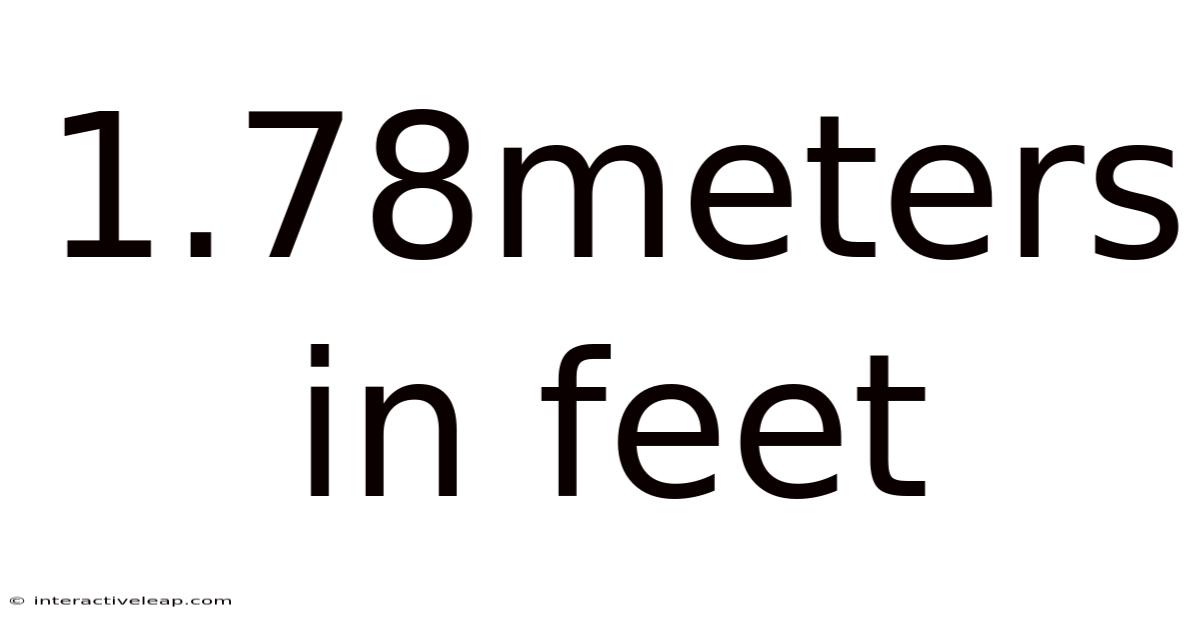1.78meters In Feet
interactiveleap
Sep 23, 2025 · 4 min read

Table of Contents
Decoding 1.78 Meters in Feet: A Comprehensive Guide
Are you curious about how tall 1.78 meters is in feet? Understanding unit conversions is crucial in various fields, from construction and engineering to everyday life. This comprehensive guide will not only tell you the equivalent of 1.78 meters in feet but will also delve into the underlying principles of unit conversion, explore practical applications, and answer frequently asked questions. We’ll also touch upon the history of measurement systems and dispel common misconceptions.
Introduction: The Importance of Unit Conversion
The world uses various systems of measurement, with the metric system (based on meters, liters, and grams) and the imperial system (based on feet, inches, pounds, etc.) being the most prevalent. Converting between these systems is essential for clear communication and accurate calculations. Understanding the conversion of 1.78 meters to feet is a simple yet illustrative example of this crucial skill. This seemingly simple conversion can have significant implications, from accurately assessing the height requirements for a building to understanding personal height comparisons in different contexts.
Converting 1.78 Meters to Feet: The Calculation
The basic conversion factor to remember is that 1 meter is approximately equal to 3.28084 feet. Therefore, to convert 1.78 meters to feet, we simply multiply:
1.78 meters * 3.28084 feet/meter ≈ 5.8399 feet
Therefore, 1.78 meters is approximately 5.84 feet.
However, for a more precise understanding, let's break down the conversion process step-by-step:
- Identify the conversion factor: As mentioned, 1 meter = 3.28084 feet.
- Set up the equation: We want to convert 1.78 meters to feet, so we set up the equation: x feet = 1.78 meters * (3.28084 feet/1 meter)
- Perform the calculation: Multiply 1.78 by 3.28084. This gives us approximately 5.8399 feet.
- Round to the desired precision: Depending on the level of accuracy needed, you can round the answer. For most practical purposes, rounding to two decimal places (5.84 feet) is sufficient.
Understanding the Metric and Imperial Systems
To fully appreciate the conversion, let's briefly examine the history and characteristics of both measurement systems:
-
The Metric System: The metric system, also known as the International System of Units (SI), is a decimal system based on multiples of 10. This makes calculations and conversions relatively straightforward. It's the most widely used system globally, particularly in science and engineering. Key units include the meter (length), kilogram (mass), and liter (volume).
-
The Imperial System: The imperial system, predominantly used in the United States, is a less standardized system with units derived from historical measurements. Conversions within the imperial system and between the imperial and metric systems can be more complex due to the lack of a consistent decimal base. Key units include the foot, inch, yard, mile, pound, and gallon.
Practical Applications of Unit Conversion: Beyond 1.78 Meters
The ability to convert units is not just an academic exercise; it has many practical applications:
-
Construction and Engineering: Converting between metric and imperial units is crucial in construction projects where blueprints might be in one system while materials are measured in another. Inaccurate conversions can lead to significant errors and potentially dangerous situations.
-
International Trade: Global trade requires seamless conversion between different units of measurement to ensure accurate pricing, shipping, and quality control.
-
Healthcare: Medical professionals often need to convert units when dealing with dosages, patient measurements, and medical equipment from different manufacturers.
-
Travel: Understanding unit conversions is helpful when traveling internationally, particularly regarding distances, speed limits, and weight restrictions for luggage.
-
Cooking and Baking: Recipes often specify ingredients in different units, requiring conversions for accurate results.
-
Sports: Many sporting events use different units for measurements (e.g., meters vs. feet in track and field).
Frequently Asked Questions (FAQs)
-
Why is the conversion factor not exactly 3.28 feet? The conversion factor is an approximation. The precise conversion is 3.280839895 feet, but for most purposes, 3.28084 or even 3.28 is sufficient.
-
How can I perform unit conversions quickly without a calculator? For quick estimations, you can use approximations. For example, you can remember that 1 meter is roughly 3.3 feet. This provides a close enough approximation for many everyday situations.
-
Are there online converters for units? Yes, numerous online converters are available that can quickly and accurately convert between various units of measurement, including meters and feet.
-
What is the difference between a meter and a yard? A meter is slightly longer than a yard. One yard is equal to 0.9144 meters.
-
How do I convert feet to meters? To convert feet to meters, you would divide the number of feet by the conversion factor (3.28084 feet/meter).
Conclusion: Mastering Unit Conversion for a Better Understanding of the World
Understanding unit conversions, particularly between metric and imperial systems, is a valuable skill applicable across many domains. The conversion of 1.78 meters to approximately 5.84 feet is a simple yet representative example of this important process. By grasping the underlying principles and practicing the calculations, you can confidently navigate situations requiring unit conversions and avoid potential errors in various aspects of life and work. Remember to choose the appropriate level of precision based on the context. While this guide focused on a specific conversion, the principles discussed are universally applicable to all unit conversions, enhancing your understanding of measurement systems and their practical significance.
Latest Posts
Latest Posts
-
Restaurant In Portuguese
Sep 23, 2025
-
75 Of 1500
Sep 23, 2025
-
Kg To Meter
Sep 23, 2025
-
192 In Binary
Sep 23, 2025
-
25 Of 105
Sep 23, 2025
Related Post
Thank you for visiting our website which covers about 1.78meters In Feet . We hope the information provided has been useful to you. Feel free to contact us if you have any questions or need further assistance. See you next time and don't miss to bookmark.